Johnny Cash
Le Grand Artiste
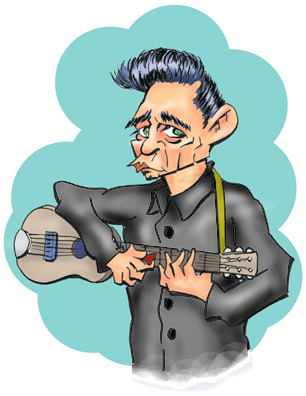
J. R. Cash
The Original
Long, long ago in a Quaint Town of the American Southwest far, far away, a gentleman was sitting in a barbershop. He was speaking to the barber and was waxing most enthusiastically about how he had just returned from Nashville. There he had attended a taping of the then popular Johnny Cash Show which appeared weekly on ABC from 1969 to 1971.
"Yeah," the customer continued, "if them ! hippies would see that show and hear what Johnny was sayin', why they'd run out and cut that there !! hair.
From his comments it's evident that the gentleman, although perhaps a fan of Johnny Cash, was not a Johnny Cash aficionado. In his songs John made it clear that he couldn't care less about young people's tonsorial adornments. If anything, he felt a solidarity with the still-extant youth movement:
A young man sittin' on the witness stand,
The man with the book says "Raise your hand."
And although the young man solemnly swore,
Nobody seemed to hear anymore.
And it didn't really matter if the truth was there.
It was the cut of his clothes and the length of his hair.
And if you look at a list of some of Johnny's guests on his show, it reads like a who-who's of singers from the - quote - "hippie era" - unquote. Pete Seeger, Joni Mitchell, Melanie, Arlo Guthrie, Ramblin' Jack Elliott, Buffy Sainte-Marie, Rod McKuen, Judy Collins, Eric Clapton, Cass Elliot, Stevie Wonder, James Taylor, Neil Young, and - yes - a Nobel Prize Winner named Robert Allen Zimmerman.
So we wonder. Was Johnny Cash really a counterculturist?
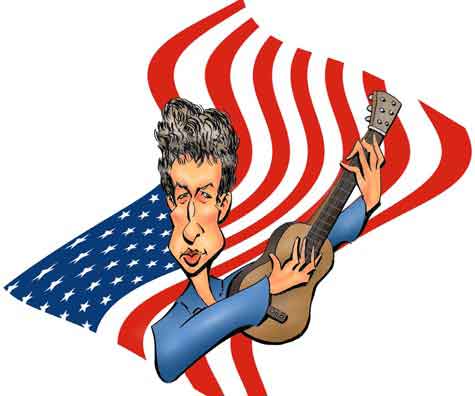
Robert Allen Zimmerman
Nobel Laureate
Well, not exactly. After all, look at the other guests that John invited. There was Henson Cargill, Eddie Albert, Gordon Lightfoot, Ian Tyson, Mitzi McCall, Dan Blocker, Merle Travis, Carl Perkins, Jerry Reed, Carrie Cash, The Buckaroos, Anita Carter, Merrilee Rush, Peggy Lee, Diana Trask, Kenny Rogers, Dusty Springfield, Floyd Cramer, Claude King, Odetta, Mickey Newbury, Tex Ritter, Hank Snow, Mason Williams, Sara Carter, Bill Monroe, Bobby Bare, Shel Silverstein, Bob Hope, Al Hirt, Mahalia Jackson, The Staple Singers, Lynn Kellogg, Evie Sands, Burl Ives, Charlie Manna, Davy Jones, Ray Price, Sonny James, The Carpenters, Red Lane, Ferlin Husky, Sylvia Tyson, Marty Robbins, The Edwin Hawkins Singers, Michael Nesmith, Liza Minnelli, Mac Davis, The Statler Brothers, Tom Brumley, Helen Carter, Homer, Connie Smith, Ed McMahon, Loretta Lynn, Doug Kershaw, Gary Scruggs, Archie Campbell, Danny Davis and the Nashville Brass, Creedence Clearwater Revival, Bonnie Owens, Tony Joe White, Bobbie Gentry, Bobbi Martin, Charlie Callas, David Houston, The Everly Brothers, Michael Parks, B.J. Thomas, Roy Clark, Jimmie Rodgers, Junior Samples, Webb Pierce, The Glaser Brothers, Tommy Cash, Roy Orbison, The Dillards, Neil Diamond, Bobby Sherman, Tom T. Hall, Kirk Douglas, Mother Maybelle Carter, Buck Owens, Joey Scarborough, Bruce and David, Jane Morgan, Ike Everly, Jackie DeShannon, Bobby Goldsboro, Lulu, Dennis Hopper, Homer and Jethro, Gordon Terry, Takahiro Saito, O.C. Smith, Anne Murray, Micky Dolenz, Charlie Brill, Conway Twitty, The Stoneman Family, Glen Campbell, Soupy Sales, The Cowsills, Tut Taylor, The First Edition, Billy Graham, José Feliciano, Vikki Carr, Louis Armstrong, The Blackwood Brothers, The Guess Who, Rosey Nix Adams, The Monkees, George Gobel, Dale Robertson, The Tennessee Three, Roy Acuff, Minnie Pearl, Joe Tex, George Lindsey, Ricky Nelson, Fannie Flagg, Albert Brooks, Jan Howard, Charley Pride, George Jones, Hank Williams Jr., Waylon Jennings, Bing Crosby, Patti Page, Brenda Lee, Grandpa Jones, Jerry Lee Lewis, Lorne Greene, Marci Dean, Chris Gantry, June Carter Cash, Lawrence Reynolds, Derek and The Dominos, Bob Luman, Sammi Smith, Tennessee Ernie Ford, John Hartford, Merle Haggard, Jim Nabors, Chet Atkins, Ray Cash, Faron Young, Kris Kristofferson, Stringbean, Pat Boone, Linda Hart, Tammy Wynette, Eric Andersen, Nancy Ames, Randy Scruggs, Ed Ames, Phil Harris, Joe South, The Oak Ridge Boys, Bill Anderson, Doug McClure, Linda Ronstadt, Dick Feller, Eddy Arnold, The Carter Family, Jeannie C. Riley, Ron Carey, Ray Charles, Stuart Hamblen, Kitty Wells, Roger Miller, Jethro, and Lynn Anderson.
Not exactly rabid agin-the-government rebels.
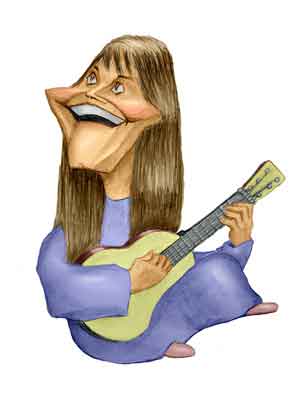
Melanie
And her.
Of course, the catholicity of the performers arose because the program was a variety show. This now extinct genre of television entertainment was itself the electronic remnant of vaudeville. There were a number of unrelated acts one after another. The idea was to have something for everyone and at a time when a household had only a single television set and everyone had to watch the shows in tandem, variety shows were a way to preserve family harmony.
Although The Johnny Cash Show was heavily weighted toward singers and other musicians, the show also featured comedians (Bob Hope, Phyllis Diller, George Gobel), television actors and personalities (Dan Blocker, Ed McMahon, Charlie Brill), actors who sang (Lorne Greene, Jim Nabors), and even individuals who defy any particular classification (Shel Silverstein). John also had a number of African-American guests in a day where networks still shied away from diversity. So we saw not only well-known musicians like the jazz trumpeter Louis Armstrong, pianist and singer Ray Charles, and the black country and western singer Charlie Pride, but even the less known rhythm and bluesman, O. C. Smith.
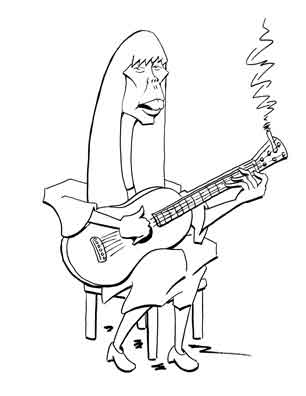
Joni Mitchell
She, too.
The appearance of Pete Seeger himself was something of a milestone. People forget that in the late 1960's Pete was emerging from nearly a decade and a half of blacklisting. True, he had never disappeared completely from the airwaves. But on John's show, Pete was playing to Middle America, and the network bigwigs had wanted to keep him off the show. John prevailed, though, and Pete was kept on camera for several songs. In many ways it was this appearance that put Pete back in America's mainstream where he remained until his death in 2014 at age 94.
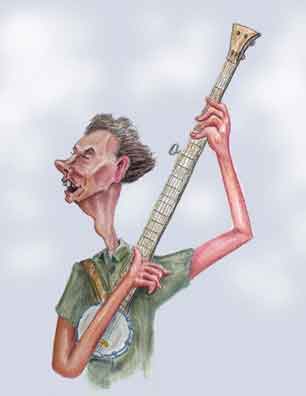
Pete Seeger
Mainstream
John was born in Kingsland, Arkansas, on February 26, 1932. The family soon moved to Dyess, near the Tennessee border and about 30 miles north-northwest of Memphis. John grew up learning to sing in church and with his friends and family.
A lot has been made of how his brother's death changed John from a cheerful and happy-go-lucky kid to a sombre, thoughtful, and God-fearing young man. The basic story is that Jack, John's senior by two years, was cutting wood with a radial arm saw. Details of the accident differ. One story is that the accident occurred in a sawmill where Jack worked and another is that it was at the school workshop. In any case someone had removed the guard and when Jack began to cut a board, the oversized blade caught the wood and pulled Jack into the blade. Suffering from a deep abdominal wound, Jack was taken to a hospital but died several days later.
John joined the Air Force in 1950 and was stationed in Germany. Everyone knows he was born without a first or middle name since his folks could only agree on the initials, "J. R." But when he enlisted, J. R. was told he had to have a full first name. So he picked "John".
During his training in San Antonio John met an exotic looking beauty, Vivian Liberto. They kept in touch when John was dispatched overseas, and in 1954 after he left the Air Force, they were married. They moved to Memphis where John worked at various jobs but also played and sang with local musicians. With his unique basso profundo voice, he made an impression.
John also played acoustical guitar, providing backup for his lead who used an electric instrument. He was, of course, quite a good player, as you can tell when he played solo. On stage, though, he sometimes would shift the guitar around for theatrical effect, playing over the body of the instrument and then shifting his pick work high up on the neck. Anyone who plays guitar knows the latter technique reduces the volume and resonance, and so when he was with the group - The Tennessee Two (or Three) - John's playing is often inaudible.
The original Tennessee Two were bassist Marshall Grant and guitarist Luther Perkins. Marshall, who was also the group's de facto road manager, originally played upright acoustic bass. But as became the custom for country groups and for the convenience and compactness, he too soon switched to electric.
Almost universally John's music has been described (perhaps a little disparagingly) as the quintessential example of the boom-chicka-boom style. With the sound largely credited to the combined technique of Marshall and Luther, that's as good a description as any.
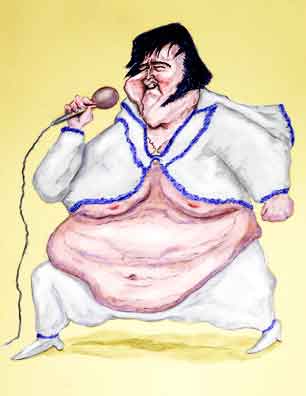
The King
He started with Sam, too.
John got into recording - as did many other fledgling singers in Memphis - by walking into Sam Phillips's recording studio and making a pitch. Sam's Sun Records had just begun reaching a national audience, and Sam was always looking for new talent. His standard modus was to cut a record and play it for the Nashville disc jockey, Dewey Phillips. If Dewey liked it, he'd put it on his show. From there it was up to the public. The Sam/Dewey consortium helped launch a number of careers including, of course, that of the King. In 1955, Sam cut John's first discs.
John's initial 45's* did surprisingly well. "Hey, Porter" with the flip side "Cry Cry Cry" made Billboard's Country Chart. "Folsom Prison Blues" - also in 1955 - reached #4, and the next year I Walk the Line hit #1. Not bad for a guy who had been really performing not much more than a year.
From then on, John was a bonafide country and western star. That doesn't mean he had it cushy, and he would perform in VFW halls and high school gyms if need be.
Although not yet in the upper tiers of celebrity, John nevertheless garnered enough recognition that in 1959 and backed by a full studio chorus, he provided the vocals for the theme song of the televison show The Rebel starring Nick Adams. Admittedly a bit hokey sounding today and many people didn't know it was John singing, the tune is nevertheless rather catchy.
Johnny Yuma was a rebel.
He roamed through the West
Did Johnny Yuma, the rebel,
He wandered alone.
Many singers have a signature song, but John had several. Of course there's I Walk the Line which was also John's first record to cross into the Pop Charts. Then there's Folsom Prison Blues which became particularly popular after his 1968 appearance at Folsom.
But it was in 1963 that Ring of Fire sent John into to the national collective consciousness. And of course there's the iconic and masterful, A Boy Named Sue.
A lot of people think that John wrote Ring of Fire which isn't correct. Instead the song was co-written by June Carter and Merle Kilgore. June herself was a member of the famous Carter Family and her mom, Maybelle, remains an icon of country music. Starting in the 1920's, the group was originally a trio of Carters composed of Mother Maybelle (as she was later called), Alvin Pleasant (called A. P. for short), and Maybelle's cousin Sara. Sara was was married to A. P., and Maybelle married A. P.'s brother, Ezra. So all indeed bore the surname "Carter", and the reader can work out the genealogy themselves.
The Carter Family had been among the most popular - if not the most popular - of the early groups performing "hillbilly music" (as country music was then called). Later the Carter Family, less A. P. (who died in 1960) but supplemented with a growing brood of younger Carters, became part of Johnny's touring group.
June, called the "onery one" of the Carter girls (by sister Helen), had recorded Ring of Fire accompanying herself on the autoharp. June's version, though, didn't sell all that well. But as we all know John added mariachi trumpets and a vocal backing with June, her sisters, and her mom. The trumpets kept the song from sounding as pure country, and teenagers could buy the record and not seem like squares*.
And what song of John's do you think hit the hightest on the Pop Charts?
Yep. A Boy Named Sue.
A Boy Named Sue - which actually reached #2 nationwide - was not written by John either, but instead by Shel Silverstein, better known in later years for his original children's books. John first publicly performed the song when he appeared at San Quentin Prison in 1969 and had only learned it shortly before from Shel. The performance at San Quentin featured Marshal on bass and the lead guitarist was Carl Perkins (no relation to Luther). John altered the lyrics a bit which ended up getting a word bleeped when it was released on the single.
But you ought to thank me before I die
For the gravel in your guts and the spit in your eye
'Cause I'm the son-of-a-! that named you "Sue".
And of course there's that perfect ending:
And I think about him, now and then
Every time I try and every time I win,
And if I ever have a son, I think I'm gonna name him....
"Bill" or "George" - anything damn thing but Sue! I still hate that name.
For what it's worth, there really was "A Boy Named Sue". Sue Hicks was one of the prosecuting attorneys at the famous "Monkey Trial" in Dayton, Tennessee in 1925. The trial is often pictured as the local townspeople risin' up against the upstart teacher who dared teach the science of evolution. This is not what happened.
The trial was contrived to test the constitutionality of Tennessee's anti-evolution law and had the full cooperation and approval of the defendant, John T. Scopes. It had been Sue who - initially somewhat jokingly - suggested to John that he serve as a test case. John said he would do so. The town fathers initially didn't take the trial too seriously and saw it as something to bring attention (and of course money) to the town. They even decided to award "Monkey Medals" to all of the participants. Fortunately that idea was scotched.
The real boy named Sue lived until 1980 and acknowledged he may have been the inspiration for the song's protagonist since Shel could have easily learned about his rather unusual name. But Sue wasn't so dubbed by his dad to put the gravel in his guts and the spit in his eye. He was named by his mother.
Like many singers John did some acting which he seemed to enjoy. Starting out on a guest slot in one of the Wagon Train episodes, he appeared on television and in movies fairly regularly. Sometimes he was a credited actor and sometimes he'd put in a cameo. He also produced, narrated, and appeared in Gospel Road: A Story of Jesus which was filmed on location in Israel. June played Mary Magdalene but the role of Jesus was not taken by John but by Robert Elfstrom who was also the director.
But it was with his own television show that John reached the true pinnacle of success. It was far more popular than other country music programs that had been on since the arrival of television. As the show started up in 1969, John was profiled in Life Magazine and even made the cover. The article stated that John made everyone like country music. That's probably a bit hyperbolic, but certainly John's popularity cut through a wide swath of the population.
Glen Campbell once said he never thought of himself as singing country music - which he classified as "you-broke-my-heart-so-I'm-gonna-break-your-neck". John also often shied from the strict C&W themes. Although he did have a lot of the pure country singers on his show - Merle Haggard, Buck Owens, Jimmie Rodgers, The Dillards - he made sure there were plenty of pop groups and as we pointed out, he didn't neglect the folk singers.
Early on John had become involved in the 1960's Folk Revival - actually the Folk Revival was a Revival of a Folk Revival. He frequented the Village in New York City, met (and sang) with the folk singers including Bob Dylan (Johnny wrote the liner notes to Bob's album Nashville Skyline). Of course John had loved American folk music ever since he was a kid. His mother, Carrie, sang folk ballads and hymns, and she was once a guest on his show.
Successful artists also tend to be savvy business people, and John was no exception. He knew that you could not alienate your customers. So although he would sing songs about helping the poor and the downtrodden, he did so in a more or less generic manner. In one song he warned his fellow singers against overt politicization of their songs:
Now this should be a lesson if you plan to start a folk group,
Don't go mixing politics with the folk songs of our land.
Just work on harmony and diction,
Play your banjo well,
And if you have political convictions
Keep them to yourself.
So why would John invite Pete Seeger whom he knew would be controversial to his show? After all, Pete had been one of the suspected subversives summoned before the House Un-American Activities Committee (HUAC). Then when he had refused to answer a question - a refusal which he said was not based on the Fifth Amendment but on the First Amendment - he was slapped with contempt of Congress.
John really didn't need a reason since Pete was simply his friend. And maybe he was just repaying a favor. In 1966 Pete had invited Johnny and June to appear on his show. That was Rainbow Quest, an educational folk music program which was broadcast to a limited audience over two seasons. When John appeared he was already a major country singer and his superstar status was just peeking up over the horizon.
One biographer mentioned that on Rainbow Quest Johnny had been "frightful". He sat twisting in his chair, exhibited facial tics, and interrupted Pete and June while wolfing down cigarettes "like chocolates". It was as if the implication was that John was pepped up on drugs.
Which given the time is certainly possible. The previous year - 1965 - Johnny made national news when he was arrested in El Paso for smuggling pills - 688 of dextroamphetamine and 474 of meprobamate - that he had brought over from Mexico.
Actually the narcotics agents had received a tip that John was smuggling heroin. He wasn't of course but the drugs he had obtained South of the Border had nevertheless been brought into the country illegally. John was hauled off to jail.
All in all it was fortunate that John was nabbed in the US. Marshall Grant, ever the problem solver, found a bondsman who got John sprung. The trial was held two months later. John pled guilty and was given a $1000 fine plus a 30-day suspended sentence.
It's certainly unfair, then, that when the popular motion picture about John's life Walk the Line depicted this episode that Vivian was shown as having a such a difficult personality that she practically drove John away from his home, hearth, and marriage. To paint such a picture, the script departed considerably from the facts (no surprise for Hollywood) and has John showing up at home after his conviction to face Vivian's wrath.
The truth is Vivian traveled to Texas to be with John for the trial. The two were photographed hand-in-hand walking out of the courthouse.
The strongest outcry from the episode, though, was not from any indignation at John's use of drugs. Instead when the papers printed Vivian's picture, many people thought she was black. Of course, people will ask what does it matter who John married. But at this time interracial couples were not only extremely unusual, but in some states the marriages were illegal. And racist hate groups in the US were as common then as they are now. Some of the more spittle-flinging racists demanded a boycott of John's records and performances.
In the end though, although some concerts were canceled, there was little effect on either John's touring schedule or his record sales. It seems then that most people really didn't care who John was married to.
However, the episode wasn't so good for Vivian. John's continuing drug use had taken its toll on her nerves, and the marriage ended in 1967. There was also the problem that John was rarely home. He'd head off on a tour and Vivian had no idea when he'd be back. Once Vivian didn't know where John was for a whole year. And Vivian had become all too aware of how John had become enamored of his singing partner, June Carter.
Everyone knows that John's second marriage in 1968 was to June (it was her third). They were certainly kindred spirits (as you could tell when they sang duets together), and John kept after her to say yes. But June had reservations since 1) he and she were both married to other people, and 2) she also was worried about his drug problem.
That there was substance abuse among the traveling entertainers, although not what we can call justifiable, is really no surprise if you look at their itineraries. In the day before air travel was routine, even big names usually moved around by car or bus. They would play a gig, drive half the night to the next town, and maybe get a quick snooze before appearing again on stage. Then they'd start all over again.
On a tour John might have a show in Tupelo, Mississippi then move on to Sheffield, Alabama the next day. From there he'd appear in Arkansas at Little Rock and Camden before hieing on back to Memphis. This was all in a five day stretch. Then he'd start off on another loop and keep the cycle up for six weeks or two months. On some days there would be more than one performance.
Even in later years when he flew by first class air, John's tours could be hectic. John would perform in Australia, Germany, England, and then on back to the USA all in the space of a week.
As to why the performers would push themselves to such health-endangering extremes, they knew the fickleness of their profession. They had to make it while they could.
So it seemed that a simple way for the performers to stay awake was just to pop a few "uppers" and then take "downers" when they needed a snooze. Marshall, who had the responsibility of making the show go on, was never sure if John would be in a condition to sing. June also put her foot down and told him he had no chance to win her over unless he gave up the drugs.
According to the movie Walk the Line John gives up drugs, marries June, and the credits roll up showing all lived happily ever after. That, we point out, was from the movie.
Sad to say although John did manage extended periods without drugs, he never completely kicked his habit. He once appeared before a massive and jam-packed religious convention and between songs told the kids how he had taken almost everything you could think of. His use of the past tense let the kids believe he had managed to throw off the chains of his addiction. Then a decade later he was on a famous talk show where he mentioned how he had been clear for the last fourteen months.
Much of John's later problems were not with what we call recreational drugs but were from mood altering pain medications. Then as now such a habit was both commonplace and easy to rationalize. Muscle aches, back pain, a broken leg, any excuse would do. When John was once asked how often he broke a leg, he replied, "Well, I kept a hammer in one pocket, and the pain killers in the other pocket."
What's even sadder is that the pressure finally got to June and she fell into the habit as well. This dependency, intermittent or not, certainly affected their health. Both died relatively young in 2003 and within a few months of each other.
Of course there are many other facets of John's life and philosophy we haven't touched on. But this essay has been, after all, about his art.
References
Johnny Cash: The Life, Robert Hilburn, Little Brown and Company, 2013.
Johnny Cash: The Biography, Michael Streissguth, Da Capo Press, 2006.
Mother Maybelle Carter's Carter Scratch, Helen Carter (Narrator, Host), Anita Carter (Narrator, Presenter), June Carter Cash (Narrator, Presenter), Johnny Cash (Narrator, Host), Greg Mogford (Director), Mebcon Production, Documentary, 1990.
"What is Truth", Johnny Cash (Composer), Columbia, 1970.
"A Boy Named Sue", Shel Silverstein (Composer), Evil Eye Music (Publisher), 1969.
"A Boy Named Sue", Johnny Cash (Performer), Shel Silverstein (Composer), Columbia, 1969.
I Was There When It Happened: My Life with Johnny Cash, Marshall Grant, Cumberland House Publishing, 2006
"Hard Times King of Song", John Frook, Life Magazine, pp. 44-48.
"Johnny Cash", Sun Records.
"Johnny Cash: Past Concerts", Songkick.
"Johnny Cash: Live Performances", Johnny Cash Info Center.
The Johnny Cash Show, Internet Movie Data Base.
Gospel Road: A Story of Jesus, Internet Movie Data Base.
"Why Hate Groups Went After Johnny Cash in the 1960's", Erin Blakemore, History Stories, August 2, 2017.
"Vivian L. Distin, 71; Inspired Hit by Husband Johnny Cash", Valerie Nelson, The Los Angeles Times, May 28, 2005.
"Singer Fined for Illegally Having Drugs", The Daily Oklahoman, Wednesday, March 9, 1966, p. 26
"Vivian Dorraine Liberto Distin", Find-A-Grave.
"Thomas Peter Liberto", Find-A-Grave.
"Irene Robinson Liberto ", Find-A-Grave.
Clarence Darrow for the Defense, Irving Stone, Doubleday, 1941.
"Johnny Cash Is Indebted To a Judge Named Sue", July 12, 1970
Late Night with David Letterman, David Letterman (Host), Johnny Cash (Guest), Waylon Jennings (Guest), February 7, 1985.
Flight, Johnny Cash General Store.